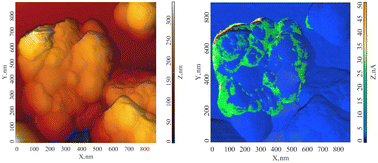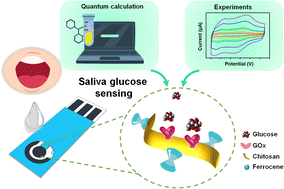Themed collection Bionanocomposites

Introduction to Bionanocomposites
Sabu Thomas, Maya John and Aji Mathew introduce the Nanoscale Advances themed issue on Bionanocomposites.

Nanoscale Adv., 2024,6, 745-746
https://doi.org/10.1039/D3NA90115G
Bionanocomposite materials for electroanalytical applications: current status and future challenges
Bionanocomposites are materials composed of particles with at least one dimension in the range of 1–100 nm and a constituent of biological origin or biopolymers.

Nanoscale Adv., 2024,6, 4736-4750
https://doi.org/10.1039/D3NA01111A
Recent progress and challenges of MOF-based nanocomposites in bioimaging, biosensing and biocarriers for drug delivery
Here, we explored the recent development of MOF-based nanomaterials for biomedical applications. MOF-based nanomaterials not only show excellent bio-imaging and biosensing performance but also can be well designed as bio-carriers in drug delivery.

Nanoscale Adv., 2024,6, 1800-1821
https://doi.org/10.1039/D3NA01075A
The emerging role of medical foods and therapeutic potential of medical food-derived exosomes
Medical food is consumed for the purpose of improving specific nutritional requirements or disease conditions, such as inflammation, diabetes, and cancer.

Nanoscale Adv., 2024,6, 32-50
https://doi.org/10.1039/D3NA00649B
Antioxidant flavonoid-loaded nano-bioactive glass bone paste: in vitro apatite formation and flow behavior
Non-cement pastes in the form of injectable materials have gained considerable attention in non-invasive regenerative medicine.

Nanoscale Adv., 2024,6, 1011-1022
https://doi.org/10.1039/D3NA00941F
Development of NIR light-responsive shape memory composites based on bio-benzoxazine/bio-urethane copolymers reinforced with graphene
In this work, shape memory polymers (SMPs) were developed from a combination of a bio-based benzoxazine (BZ) monomer and polyurethane prepolymer (PU-prepolymer), both derived from bio-based raw materials.

Nanoscale Adv., 2024,6, 499-510
https://doi.org/10.1039/D3NA00647F
Graphene oxide nanosheets augment silk fibroin aerogels for enhanced water stability and oil adsorption
Enhanced intermolecular interactions between silk and graphene oxide nanosheets stabilize nanocomposite aerogels for enhanced water stability and hydrophobic properties, enabing rapid oil adsorption.

Nanoscale Adv., 2023,5, 6078-6092
https://doi.org/10.1039/D3NA00350G
In situ modified nanocellulose/alginate hydrogel composite beads for purifying mining effluents
Biobased adsorbent beads with anionic charge used in three-dimensional (3-D) column filters for large-volume, high flux water treatment under atmospheric pressure.

Nanoscale Adv., 2023,5, 5892-5899
https://doi.org/10.1039/D3NA00531C
In vitro anti-prostate adenocarcinoma and lung cancer studies of phenoxyaniline-block-poly(methyl methacrylate) based nanocomposites via controlled radical polymerization
A phenoxyaniline-based macroinitiator is utilized for the first time in order to produce phenoxyaniline-block-poly(methyl methacrylate) composites through single electron transfer-living radical polymerization (SET-LRP) under mild conditions.

Nanoscale Adv., 2023,5, 5870-5879
https://doi.org/10.1039/D3NA00644A
A nanoscale study of the structure and electrical response of Sepia eumelanin
Conductive-atomic force microscopy reveals a nanoscale electrical response from films obtained from ink formulations including Sepia melanin, a biopigment of interest for sustainable organic electronics.

Nanoscale Adv., 2023,5, 5295-5300
https://doi.org/10.1039/D3NA00355H
Dipole moment as the underlying mechanism for enhancing the immobilization of glucose oxidase by ferrocene-chitosan for superior specificity non-invasive glucose sensing
This study showcases the integration of experimental and theoretical approaches for optimizing the biosensor.

Nanoscale Adv., 2023,5, 4881-4891
https://doi.org/10.1039/D3NA00340J
Effect of the combined addition of ultrasonicated kraft lignin and montmorillonite on hydroxypropyl methylcellulose bionanocomposites
Lignin caused montmorillonite exfoliation improving clay compatibility with HPMC, and conferred UV-shielding, antioxidant and antibacterial properties, while montmorillonite improved barrier properties.

Nanoscale Adv., 2023,5, 4107-4123
https://doi.org/10.1039/D3NA00283G
Biomass-derived carbon deposited TiO2 nanotube photocatalysts for enhanced hydrogen production
In this study, titanium oxide nanotubes (TiO2NTs) were deposited on the surface of activated carbon (AC) by varying the wt% of AC.

Nanoscale Adv., 2023,5, 3671-3683
https://doi.org/10.1039/D3NA00211J